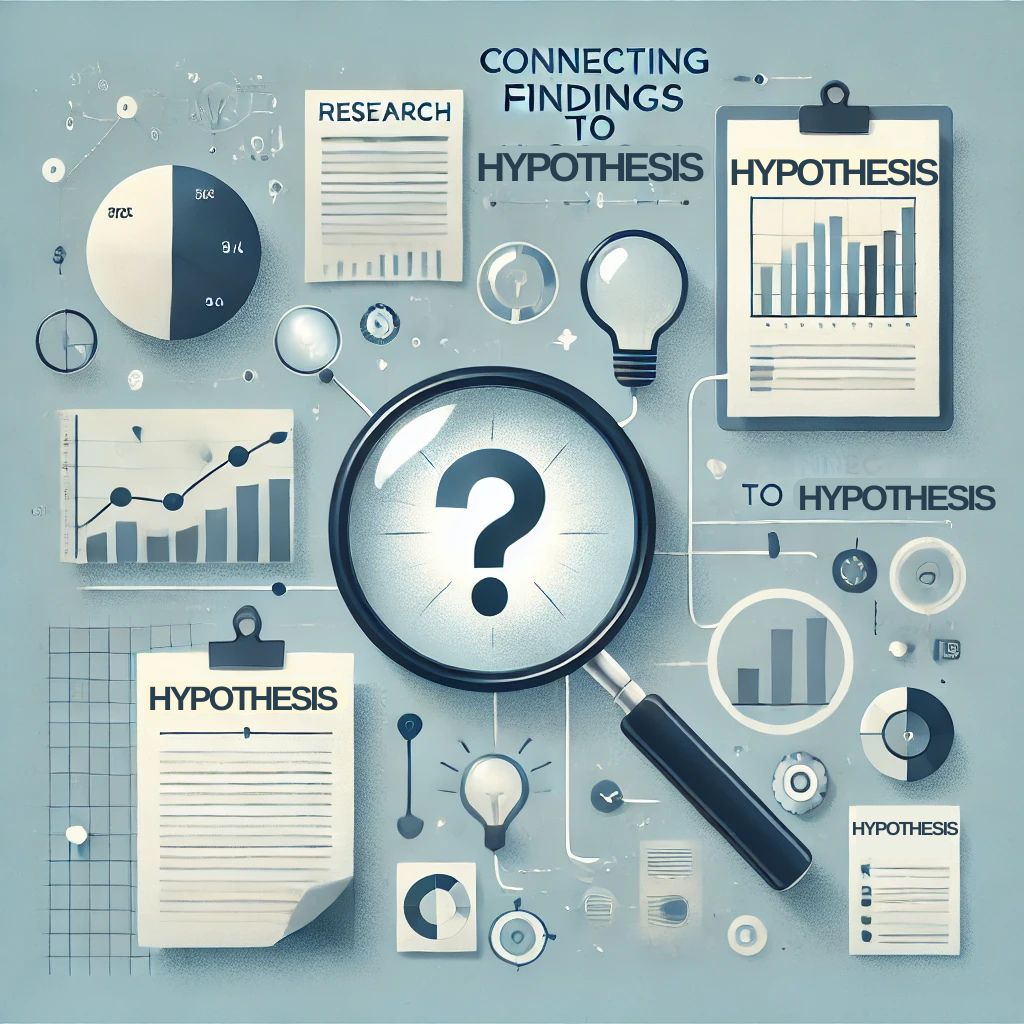Introduction
In academic research, connecting findings to hypothesis is crucial for validating the research question and ensuring the study achieves its purpose. A hypothesis is a tentative statement predicting the relationship between variables, which researchers test through analysis and data collection. Properly linking findings to a hypothesis ensures that research conclusions are meaningful and impactful.
With tools like MyWordAi.com, an automated academic writer powered by ChatGPT, students and researchers can now simplify this process. MyWordAi provides pre-prompted templates and AI-generated assistance, helping users connect their findings with their hypotheses effectively. This academic tool is available on the Google Play Store: Download MyWordAi.

Understanding Research Hypothesis
A research hypothesis is a prediction that a researcher makes about the relationship between two or more variables. It guides the study by setting the expectations for what the researcher aims to prove or disprove. There are two key types of hypotheses:
- Null Hypothesis (H₀): Assumes no relationship exists between variables.
- Alternative Hypothesis (H₁): Proposes that a relationship does exist between the variables.
Hypotheses play a critical role in determining the focus of the study and driving data collection. Every research project must identify the hypotheses upfront to allow proper validation in the analysis phase.
Interpreting Research Findings
Once data is collected, interpreting the findings correctly becomes essential for linking them to the hypothesis. Quantitative research often relies on statistical tests (e.g., t-tests, chi-square tests) to confirm or refute relationships between variables, while qualitative research employs coding techniques to identify recurring themes or patterns in the data.
For example:
- If a hypothesis predicts a positive correlation between hours studied and exam performance, quantitative analysis may involve calculating a correlation coefficient to determine the strength of the relationship.
- In a qualitative study, findings might reveal recurring themes about student motivation, confirming or refuting a hypothesis about study habits.
Interpreting findings is key to understanding whether they align with the initial research hypothesis or suggest alternative conclusions.
Connecting Findings to Hypothesis: Linking Findings to Hypothesis
The heart of any research lies in connecting findings to the hypothesis. Researchers must assess whether their data supports or contradicts their predictions. A well-written discussion section presents findings logically and relates them directly to the hypothesis.
Here are steps to properly link findings to hypotheses:
- State your findings clearly: Use tables, graphs, or summarized statements to present key data.
- Analyse findings in the context of the hypothesis: Highlight any patterns or results that align with or contradict the hypothesis.
- Consider statistical significance: Confirm whether the results are meaningful beyond random chance (in quantitative studies).
- Explain unexpected results: Acknowledge findings that do not align with the hypothesis and provide possible explanations.
Example:
- Hypothesis: “Students who receive weekly feedback perform better academically.”
- Finding: Students who received feedback showed a 15% higher performance in assessments.
- Conclusion: The findings support the hypothesis, confirming that regular feedback improves student outcomes.
Writing Research Conclusions
A well-written research conclusion summarizes the key findings and directly states whether the hypothesis was validated or not. The conclusion should reflect on the study’s outcomes while also addressing any limitations that might affect the results.
For instance:
- If the findings support the hypothesis, say: “The hypothesis that weekly feedback improves academic performance was supported by the study’s results.”
- If the hypothesis was not supported, acknowledge it and suggest areas for further research: “The hypothesis was not validated, suggesting other factors may influence academic outcomes.”
The conclusion provides clarity on the overall study results and aligns them with the initial research objectives.
How MyWordAi.com Helps Researchers Connect Findings to Hypothesis
Using MyWordAi.com makes writing academic papers more efficient. This AI-powered tool offers pre-prompted templates specifically designed for connecting findings with hypotheses, simplifying the process for both novice and experienced researchers. Below is a step-by-step guide to using MyWordAi for research writing:
Step-by-Step Guide: Connecting Findings to Hypothesis with MyWordAi
- Download the MyWordAi app from the Google Play Store: Get the App Here.
- Select the pre-prompted template for academic papers. Choose a research structure based on your needs (e.g., quantitative or qualitative studies).
- Enter your research data and hypothesis. MyWordAi will generate suggestions for connecting findings to your hypothesis.
- Review AI-generated content. Ensure it aligns with your research objectives and make any necessary edits.
- Generate conclusions. MyWordAi will help you draft a logical conclusion based on your findings, ensuring clarity and academic formatting.
- Format your paper. Use MyWordAi’s formatting tools to align your work with academic standards.
Using MyWordAi saves time, reduces the chances of formatting errors, and assists researchers by automating the most challenging parts of academic writing.
Conclusion
For students and researchers struggling with academic writing, MyWordAi.com offers an efficient solution. With pre-prompted templates powered by ChatGPT, it helps connect findings with hypotheses seamlessly. Download the MyWordAi app today to make research writing easier and more effective: Get the MyWordAi App Here.